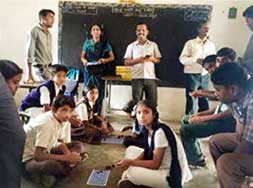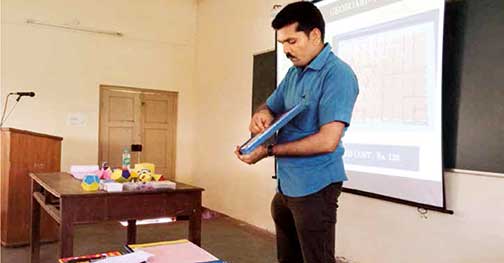Praveen Kumar Singh
Teacher
Grade: 7–12
Subject: Maths and science
Location: Mysore, Karnataka
School type: Government school
Introduction
Praveen Kumar Singh who works in Mysore district in Karnataka in the south-west of India reports on an initiative that is making use of a WhatsApp group linked to a science teachers community. The project currently involves 87 teachers from at least 70 schools.
Why technology is being used
Heggadadevana Kote (HD) taluk (an administrative region) is considered a very deprived region of Karnataka with a severe shortage of teachers in government schools. The morale of the teachers is believed to be low and the teachers do not feel that they receive much support to help them in teaching. To strengthen science education, a forum for teachers was created to promote learning and sharing about science and science teaching. This was a voluntary initiative and led to the formation of a WhatsApp group. The group discusses topics based on the curriculum on a weekly basis through audio, text, photos and videos. The use of the WhatsApp group has now spread across the district.
How it works
The forum – Vijnana Vedike Kote (ViVeK) – was started to promote interaction among the teachers to learn from each other’s experiences and not allow geographical challenges to be a limiting factor. It was observed that science education was limited to lectures and encouraging the students to obtain just enough marks to pass their examinations. The goal of the initiative was therefore to improve the quality of science education in the government schools of the ‘taluk’ through capacity-building activities for the teachers. By encouraging the teachers to clarify their doubts, it was intended to create a conducive environment for the teachers to ask more questions and promote hands-on learning.
 Starting with simple daily updates, the WhatsApp group became a vibrant discussion group with one topic being discussed every week. Every Sunday the topic for the week, which is decided by a group of teachers, is announced and the teachers send in their questions to the moderator (an expert nominated by the group or someone who volunteers) by the Thursday of the following week. The expert then moderates a discussion on the Saturday night based on the questions received. Being a Saturday night this was in the teacher’s own time. The bilingual discussions focused on addressing the conceptual gaps of the teachers with the support of audio clips, sketches, videos and text messages.
Starting with simple daily updates, the WhatsApp group became a vibrant discussion group with one topic being discussed every week. Every Sunday the topic for the week, which is decided by a group of teachers, is announced and the teachers send in their questions to the moderator (an expert nominated by the group or someone who volunteers) by the Thursday of the following week. The expert then moderates a discussion on the Saturday night based on the questions received. Being a Saturday night this was in the teacher’s own time. The bilingual discussions focused on addressing the conceptual gaps of the teachers with the support of audio clips, sketches, videos and text messages.
The group slowly evolved guidelines on how the discussion could be moderated. Praveen argues that the use of WhatsApp has helped the teachers communicate with each other. These discussions are complemented with hands-on sessions and all the information is archived and shared over Google Drive along with a series of articles on a blog. The group started with about 20 teachers in 2014 and there are currently 87 members. On an average about 30 teachers actively participate in the weekly discussions.
 What they observed
What they observed
Praveen says, ‘The results have been very encouraging. There is a tangible increase in the interest levels and confidence among the teachers in handling classes based on the topics which have been discussed. The teachers actively meet once a month at one of the schools and participate in hands-on sessions. The teachers have carried these experiences back to their classrooms. The teachers themselves now feel that their classes are more interactive and activity-based. The perception that science is a difficult subject is also on the decline and it can also be observed in the increase in the number of admissions into the science stream after 10th grade. The approach of the teachers has also shifted from a marks-oriented one to a learning-oriented one. Most satisfying is the enthusiasm among the teachers and the desire to learn more. Four teachers have now prepared a handbook on one of the topics to address the conceptual gaps. The handbook has become very popular among the other teachers.’
Through online materials, the group is reaching out to over 6,000 teachers across the state through a number of platforms.
The way forward
Praveen proposes that ‘this model can be implemented by other organizations as well. Building a strong rapport among the participating teachers and the moderators is key to the success of this model. Complementing the online discussions with a set of other activities for getting to know each other might also be necessary. This model cannot be scaled rapidly and the discussions are also not fruitful in larger groups. It has been observed that more than 20 active members in a discussion group becomes difficult for the moderator to manage.’
Challenges
Establishing the forum initially faced three challenges:
- Usage of smartphones among teachers: this was low and to convince the teachers to invest in a phone was difficult at first. This issue was tackled over several months by seeking the support of early adopters to exert pressure on other teachers to see this as an investment for their professional development.
- Connectivity and bandwidth: a lot has changed over the last three years in the rural areas in terms of connectivity, although this continues to be a challenge in a few areas.
- Archiving and public access: a new member of the group would not be able to access the discussions held earlier in the group and the group itself is limited to 250. They now archive the content on Google Drive and this is shared more widely.
To find out more
A sample handbook can be found here: https://janabandi.wordpress.com/
This is an excerpt from Teaching and technology: Case studies from India, edited by Gary Motteram and reproduced with permission from Central Square Foundation and British Council India. The full publication with many more case studies can be found here: http://centralsquarefoundation.org/research/teaching-technology-case-studies-india/

